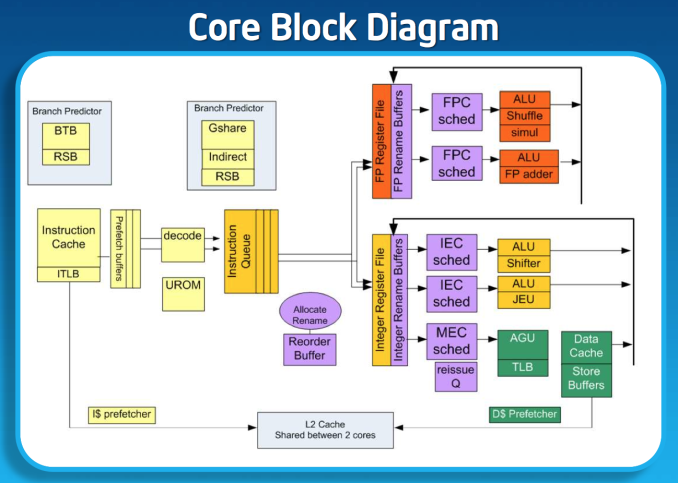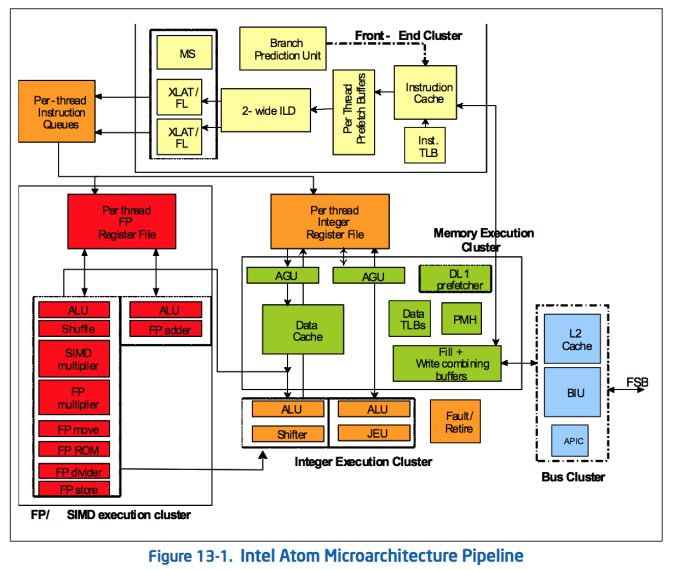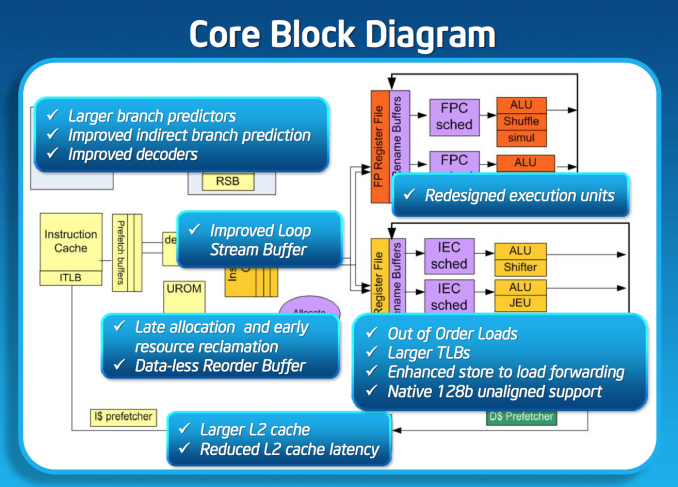Intel’s Silvermont Architecture Revealed: Getting Serious About Mobile
by Anand Lal Shimpi on May 6, 2013 1:00 PM EST- Posted in
- CPUs
- Intel
- Silvermont
- SoCs
Sensible Scaling: OoO Atom Remains Dual-Issue
The architectural progression from Apple, ARM and Qualcomm have all been towards wider, out-of-order cores, to varying degrees. With Swift and Krait, Apple and Qualcomm both went wider. From Cortex A8 to A9 ARM went OoO and then from A9 to A15 ARM introduced a significantly wider architecture. Intel bucks the trend a bit by keeping the overall machine width unchanged with Silvermont. This is still a 2-wide architecture.
At the risk of oversimplifying the decision here, Intel had to weigh die area, power consumption as well as the risk of making Atom too good when it made the decision to keep Silvermont’s design width the same as Bonnell. A wider front end would require a wider execution engine, and Intel believed it didn’t need to go that far (yet) in order to deliver really good performance.
Keeping in mind that Intel’s Bonnell core is already faster than ARM’s Cortex A9 and Qualcomm’s Krait 200, if Intel could get significant gains out of Silvermont without going wider - why not? And that’s exactly what’s happened here.
If I had to describe Intel’s design philosophy with Silvermont it would be sensible scaling. We’ve seen this from Apple with Swift, and from Qualcomm with the Krait 200 to Krait 300 transition. Remember the design rule put in place back with the original Atom: for every 2% increase in performance, the Atom architects could at most increase power by 1%. In other words, performance can go up, but performance per watt cannot go down. Silvermont maintains that design philosophy, and I think I have some idea of how.
Previous versions of Atom used Hyper Threading to get good utilization of execution resources. Hyper Threading had a power penalty associated with it, but the performance uplift was enough to justify it. At 22nm, Intel had enough die area (thanks to transistor scaling) to just add in more cores rather than rely on HT for better threaded performance so Hyper Threading was out. The power savings Intel got from getting rid of Hyper Threading were then allocated to making Silvermont an out-of-order design, which in turn helped drive up efficient use of the execution resources without HT. It turns out that at 22nm the die area Intel would’ve spent on enabling HT was roughly the same as Silvermont’s re-order buffer and OoO logic, so there wasn’t even an area penalty for the move.
The Original Atom microarchitecture
Remaining a 2-wide architecture is a bit misleading as the combination of the x86 ISA and treating many x86 ops as single operations down the pipe made Atom physically wider than its block diagram would otherwise lead you to believe. Remember that with the first version of Atom, Intel enabled the treatment of load-op-store and load-op-execute instructions as single operations post decode. Instead of these instruction combinations decoding into multiple micro-ops, they are handled like single operations throughout the entire pipeline. This continues to be true in Silvermont, so the advantage remains (it also helps explain why Intel’s 2-wide architecture can deliver comparable IPC to ARM’s 3-wide Cortex A15).
While Silvermont still only has two x86 decoders at the front end of the pipeline, the decoders are more capable. While many x86 instructions will decode directly into a single micro-op, some more complex instructions require microcode assist and can’t go through the simple decode paths. With Silvermont, Intel beefed up the simple decoders to be able to handle more (not all) microcoded instructions.
Silvermont includes a loop stream buffer that can be used to clock gate fetch and decode logic in the event that the processor detects it’s executing the same instructions in a loop.
Execution
Silvermont’s execution core looks similar to Bonnell before it, but obviously now the design supports out-of-order execution. Silvermont’s execution units have been redesigned to be lower latency. Some FP operations are now quicker, as well as integer multiplies.
Loads can execute out of order. Don’t be fooled by the block diagram, Silvermont can issue one load and one store in parallel.













174 Comments
View All Comments
Amoro - Monday, May 6, 2013 - link
In the first sentence of the paragraph below the Saltwell Vs. Silvermont graph, it states "In terms of absolute performance, Saltwell’s peak single threaded performance is 2x that of Saltwell" and it should be "Silvermont's peak single...."ClockworkPirate - Monday, May 6, 2013 - link
Also at the end of the first paragraph on the "Tablet Expectations and Performance" page, "...with Haswell picking up above Haswell." should probably be "...with Haswell picking up above Bay Trail."chrone - Monday, May 6, 2013 - link
this is the soc i've been waiting for since 2008. winter is coming!! it's gonna be a long winter for arm and friends ahead. \m/theos83 - Monday, May 6, 2013 - link
lol...wait and watch...it has been a long winter for intel (from a mobile market point of view), lets see what they end up with in the next 4 years...ARM and friends are not going away anytime soon.Hector2 - Friday, May 17, 2013 - link
True. The difference between then and now is that Intel didn't have an SoC designed and optimized for smartphones. Now they do (this year) and it'll be about 22nm & 14nm offering Intel higher performance, lower power and lower cost. In this area Intel has about a 2 year lead on their competitionKrysto - Monday, May 6, 2013 - link
It's very, very, VERY hard to beat a monopoly in a certain market (ARM that is), even with a company like Intel that may have a monopoly in another.Plus they have like a dozen competitors there, with at least 3-4 top ones. Intel has promised a lot of stuff before, and under-delivered. So we'll see. ARM chips are also going 20nm and 64 bit next year, and at 14nm FinFET the year after that (yes, only a year later).
Plus, if these things cost 2-3x what the high-end ARM chips cost, they can just pack and go home. No OEM will accept that, unless Intel gives them Haswell in PC's for 30% off, or some deal like that (which would mean they won't be making any money on these Atoms anytime soon).
klmccaughey - Tuesday, May 7, 2013 - link
Intel has the cash to loss-lead on this and open a big crack into the market. It also has the bucks to advertise.My guess is that shareholders are screaming for Intel to get into this market. All the omens look good and I am really looking forward to a big jump in power and battery life for mobiles. I think ARM finally has a real competitor.
HisDivineOrder - Tuesday, May 7, 2013 - link
Intel (and MS) are still under the delusion they're in the 1990's where they could be a premium vendor. Look at all the Windows tablets for proof of this. Intel and MS are both charging way more than they should and all their Wintel tablets (RT or 8) are overpriced by a huge amount.Intel doesn't loss lead. At least, they haven't shown any sign of it at all. Maybe this will be their moment, but somehow... I really, really doubt it.
zeo - Wednesday, May 8, 2013 - link
Don't confuse Intel with the OEMs and MS, Intel isn't over charging on their hardware!The listed Tray cost for the Clover Trail Z2760 SoC is only $41, at a time when ARM high end SoCs are starting to go over $30... So there's not a multiple times cost difference anymore.
OEMs just mistakenly took their cue from MS pricing of the Surface and it's not like the tablet market is really set up for PC configurations.
OEMs for example are used to using internal drive capacity as a way of charging more of their products. Like it doesn't cost anywhere near $50 to double the drive capacity of a Nexus 7 for example or how Apple charges a $100 for each doubling of capacity.
Remember, Windows tablets start with 32GB and that's much higher minimum than what mobile devices still offer.
Along with inclusion of full size USB ports, the added cost of Windows license, the greater tendency to include premium parts like WACOM digitizers, etc all added together for how the pricing finally came out...
However, the OEMs should have learned their lessons, MS is definitely going to offer them better volume license fees this time around, and Bay Trail is suppose to be even lower priced than Clover Trail... So we should see much better pricing with this new generation of products.
BSMonitor - Wednesday, May 8, 2013 - link
Its not a monopoly. There are several companies that build ARM SoC's. ARM is an ISA, no different than x86. If Intel delivers quantity, better performaning SoC's than the competitors, best believe they will switch. Apple already does x86 in house on OS X. Promise you they have been testing Atom in house for potential future designs.. Whether those designs win over ARM A# in house designs is another matter... Intel is nothing if not good at getting companies to sign up with them.. They deliver the highest quality and highest quantities of anyone in the silicon business.